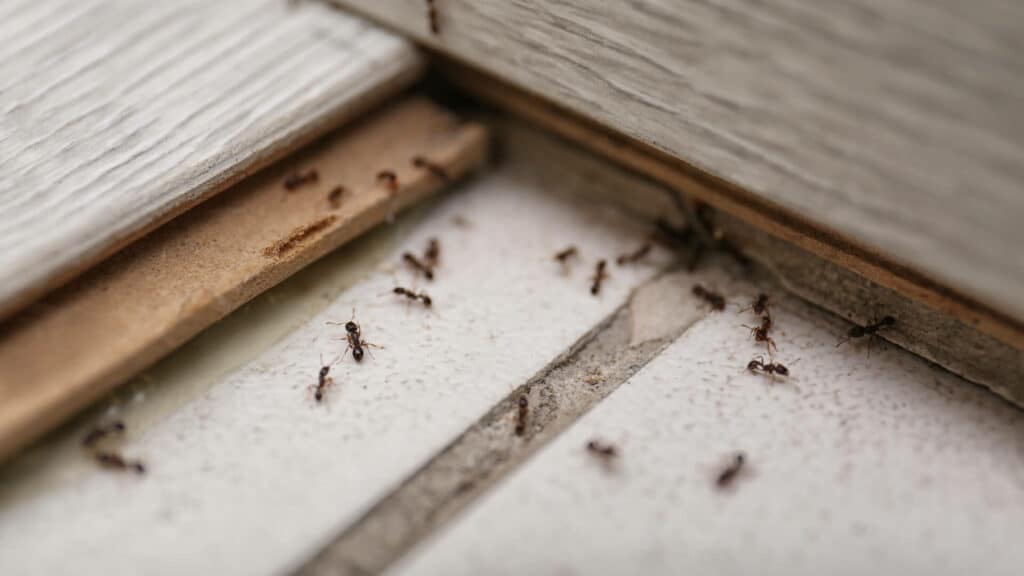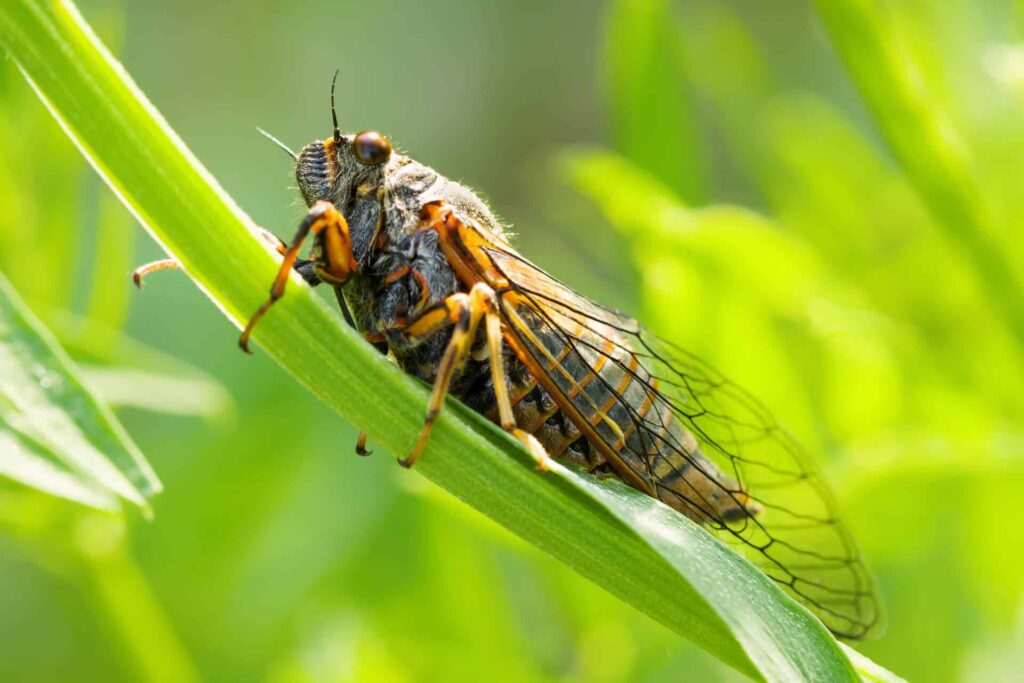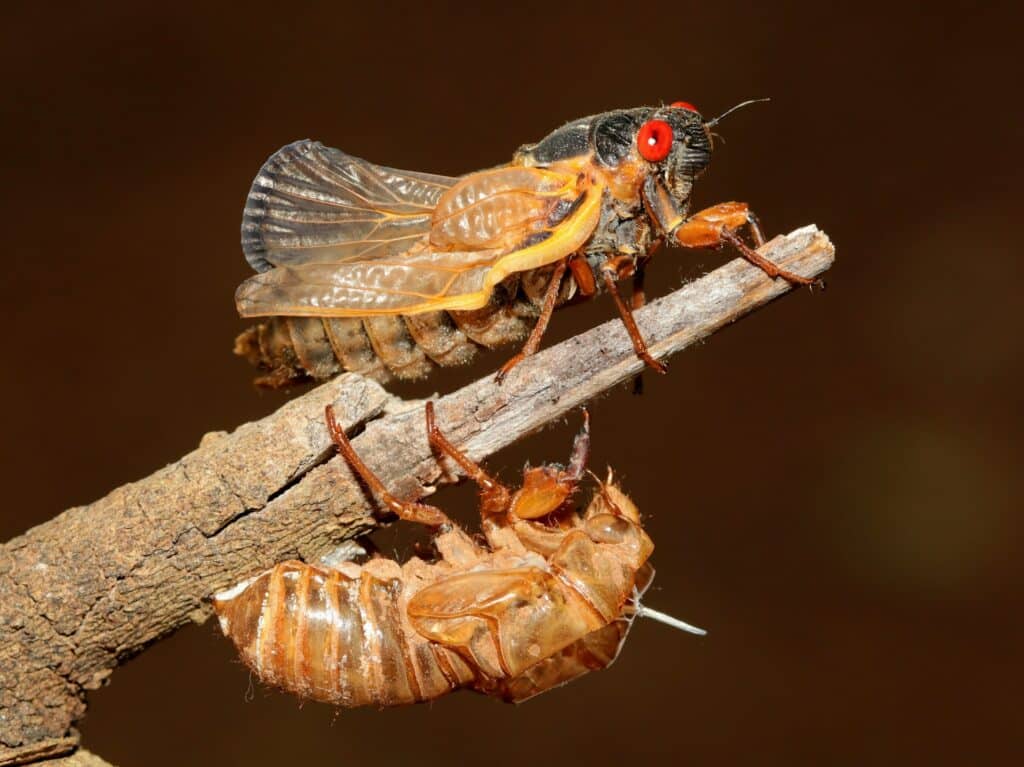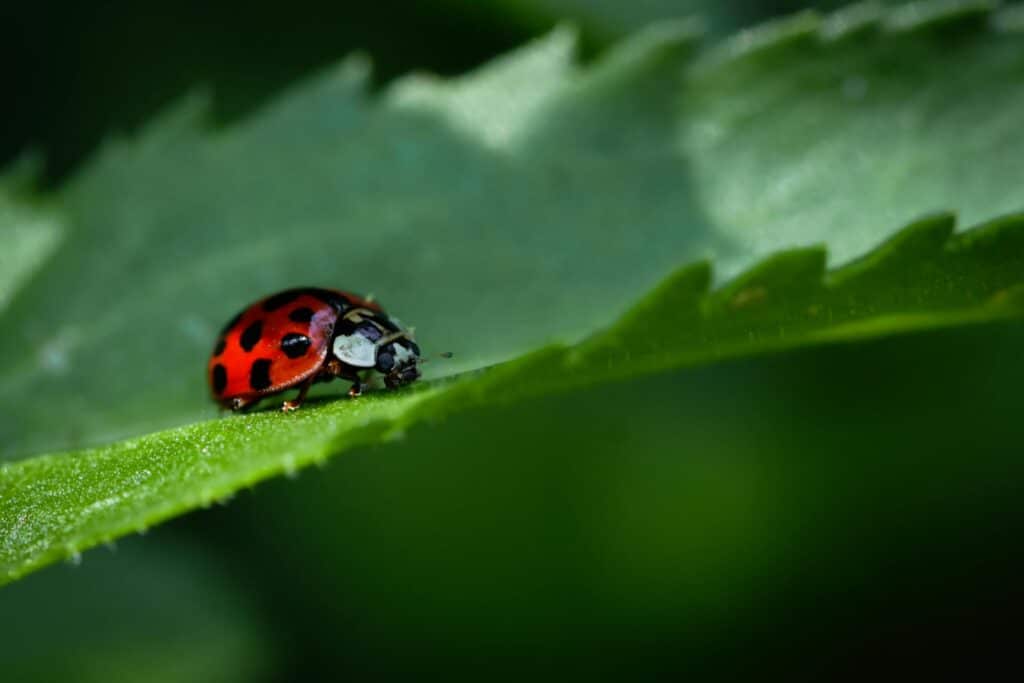June bugs, also known as June beetles, belong to the scarab beetle family. With their inch-long bodies and distinctive patches of color, they can be found in various parts of North America.
June bugs are well-known for their nocturnal habits and strong attraction to light sources. If you’ve ever spent time in your backyard during the summer evenings, chances are you’ve encountered these buzzing visitors. But did you know that beneath the surface lies an entirely different world? June bug grubs lurk in the soil, often causing problems for plants by feeding on roots.
In this brief overview of June bugs, we’ll delve into these pests and shed light on why they can become a nuisance in your landscape. So, let’s dive in and uncover the secrets of these fascinating insects!
Fascinating Facts about June Bugs
June bugs, also known as tenlined June beetles, are intriguing creatures with a lifespan of approximately one year. These peculiar insects spend most of their lives underground as larvae before emerging into the world as adults. Let’s delve deeper into some captivating facts about these buzzing creatures.
Underground Larval Life
The life cycle of a June bug begins when the female lays her eggs in the soil during late spring or early summer. Once hatched, the larvae burrow deep into the ground, where they remain for an extended period. This subterranean lifestyle can last anywhere from three to four years, depending on environmental conditions and species variation.
During this time, June bug larvae feed voraciously on plant roots. Their insatiable appetite can cause damage to crops and lawns if their population becomes too abundant. However, this feeding behavior plays a vital role in nutrient recycling within ecosystems.
Buzzing Flight and Clumsy Movements
One cannot mistake the distinctive buzzing sound produced by a june bug in flight. As they take to the air during warm summer evenings, their loud and erratic flight pattern captures attention. These insects are not renowned for their graceful movements; instead, they often appear clumsy and uncoordinated.
Their buzzing flight is not only a result of rapid wing beats but also serves as a means of communication between males and females seeking mates. The unique sound emitted by male june bugs attracts potential partners from afar, contributing to their reproductive success.
Foliage Feeding Adults
Once June bugs complete their transformation from larvae to adults, they emerge from the ground ready to explore the world above. Adult June bugs primarily feed on foliage during their short lifespan as flying insects.
Exploring the Scale of June Bug Varieties: Not all June bugs are created equal. From the buzzing ten-lined June beetle to the striped brown beetle with white stripes, there are numerous species that vary distinctly in appearance and behavior. Each species, whether it be the hissing beetle or the more common brown June beetle, offers a unique glimpse into the adaptability and variety present within these fascinating insects. Understanding these differences can provide insights into their ecological roles and how they interact with their surrounding environment.
These nocturnal creatures are drawn to various types of vegetation such as trees, shrubs, and ornamental plants. They consume leaves using specialized mouthparts designed for chewing. While June bugs may nibble on foliage, they rarely cause significant harm to plants unless present in large numbers.
In some instances, June bugs can become a nuisance when they congregate around outdoor lights or accidentally find their way indoors. Their clumsy flight patterns often lead them to collide with objects and people, causing momentary chaos but no real harm.
As we unravel the mysteries surrounding June bugs, it becomes clear that these insects play a unique role in nature. From their lengthy underground existence as larvae to their buzzing flights and foliage feasting as adults, these creatures leave an indelible mark on our summer nights. So next time you encounter a June bug, take a moment to appreciate the fascinating world they inhabit just beneath our feet.
Unveiling the Life Cycle of June Bugs: From Larvae to Adults
The life cycle of a June bug is a fascinating journey that encompasses four distinct stages: egg, larva, pupa, and adult. Each stage plays a crucial role in the development and survival of these intriguing creatures.
Female June bugs begin their life cycle by laying eggs in the soil during the early summer months. These tiny eggs are carefully deposited near plants or in areas abundant with organic matter. Once laid, these eggs serve as the starting point for the next generation of June bugs.
From these eggs emerge larvae, commonly known as white grubs. The larval stage is characterized by their pale appearance and voracious appetite. These grubs live underground, where they feed on roots, decaying plant material, and other organic matter. Their feeding habits can sometimes cause damage to lawns and crops, making them a nuisance for gardeners and farmers alike.
As white grubs continue to consume nutrients from the soil, they grow in size over several weeks or even months. This period marks an important phase in their development as they prepare for their transformation into adult beetles. During this time, they molt several times before reaching maturity.
Once fully grown, the larvae enter the pupal stage. Within protective chambers constructed underground or hidden within plant debris, significant changes occur within their bodies. During this transformative period, the larvae undergo metamorphosis as they develop into adult beetles.
After completing their remarkable transformation inside pupae casings, adult June bugs emerge from beneath the ground to take flight. These adults are commonly referred to as beetles due to their hard exoskeletons and distinctive wing covers that shield their delicate wings underneath.
Adult June bugs play an essential role in pollination as they navigate through various habitats searching for mates and sources of nourishment such as flowers or tree sap. Their presence contributes to maintaining biodiversity by aiding in cross-pollination and promoting the growth of diverse plant species.
While June bugs are often associated with their namesake month, it is worth noting that different species may have variations in their life cycles. For instance, the Japanese beetle and European chafer follow a similar life cycle pattern but differ in appearance and behavior.
Habitat and Habits of June Bugs
June bugs, also known as green June bugs or green June beetles, are fascinating insects that have distinct habitat preferences and interesting habits.
Adult June bugs prefer areas with abundant vegetation like gardens and lawns. These resilient insects are commonly found in regions where plant life thrives. Their affinity for gardens and lawns is due to the availability of ample foliage and a diverse range of plants. In these lush environments, they can easily find both food sources and suitable places to lay their eggs. It’s not uncommon to spot them buzzing around flower beds or resting on leaves during warm summer evenings.
They are attracted to decaying organic matter such as compost piles or fallen fruits. June bugs have a penchant for decomposing organic material, which provides them with nourishment at various stages of their life cycle. Compost piles, rich in decaying plant matter, serve as a buffet for these voracious eaters. Fallen fruits in orchards or beneath trees are also prime feeding grounds for adult June bugs. Their attraction to decaying matter plays an essential role in nutrient recycling within ecosystems.
During mating season, male June bugs can be seen flying around searching for females. Mating season is an exciting time when male June bugs take to the skies in search of potential mates. With their distinctive buzzing flight pattern, they navigate through the air in pursuit of female companionship. This behavior often results in swarms of males hovering above gardens or fields during the breeding period.
As we delve deeper into the world of June bugs, it becomes evident that they thrive in areas teeming with vegetation and decaying organic matter while displaying intriguing mating rituals during specific periods.
So next time you encounter a green June bug or green June beetle, take a moment to observe their surroundings. You may find yourself marveling at the intricate relationship between these insects and the natural world they inhabit.
Effective Methods to Control June Bugs
Excess moisture in lawns can attract adult June bugs, leading them to lay eggs and cause damage. By taking proactive measures to remove this excess moisture, you can effectively deter these pests from infesting your lawn.
One method that has shown some effectiveness in controlling the population of June bugs is by applying beneficial nematodes to the soil. These microscopic worms are natural predators of beetle larvae and may help reduce their numbers. When applied correctly, nematodes penetrate the soil and actively seek out larvae to feed on them, ultimately decreasing their population.
In addition to using beneficial nematodes, physical barriers can be employed as a preventive measure against adult June bugs damaging plants. Mesh screens or row covers act as protective shields that prevent beetles from reaching your precious foliage. By installing these barriers around vulnerable plants, you create a physical obstacle that keeps the adult beetles at bay.
While removing excess moisture and implementing physical barriers are effective methods for controlling June bug populations, it’s important to remember that complete elimination may not be possible. However, by combining multiple strategies, you may be able to reduce their impact on your lawn and garden.
To summarize:
- Remove excess moisture from lawns
- Apply beneficial nematodes
- Use physical barriers like mesh screens or row covers
By following these steps consistently throughout the season, you’ll have a better chance of keeping June bug populations under control.
Regularly inspecting your lawn for signs of infestation allows you to take action promptly before significant damage occurs. If you notice any telltale signs such as chewed leaves or patches of dying grass, it’s time to implement control measures immediately.
Remember that controlling June bugs requires persistence and patience. It may take some time before you see noticeable results. However, with a combination of proper lawn care practices and targeted pest control methods, you can effectively manage these pesky insects and enjoy a healthier, more vibrant garden.
Applying Insecticides for June Bug Control
Insects can often wreak havoc on our lawns, causing damage to the grass and overall aesthetic appeal. One common culprit that homeowners encounter is the June bug. These pesky beetles can quickly multiply and become a nuisance if left unchecked. Luckily, there are effective ways to control them, such as applying insecticides containing active ingredients like imidacloprid or carbaryl.
Using insecticides can be an essential tool in your arsenal. Products containing imidacloprid or carbaryl are commonly used in controlling adult beetles. Imidacloprid works by targeting the nervous system of the insects, while carbaryl disrupts their feeding activities. Both options provide reliable results when used correctly.
For best results, it is crucial to follow the instructions provided by manufacturers when applying insecticides, and always consider the safety guidelines and regulations in your area. This includes carefully measuring and mixing the product according to the recommended ratios. Wearing protective gear such as gloves and masks is advisable to prevent any potential health hazards.
Timing is also a critical factor when applying insecticides for June bug control. It is best to avoid treating your lawn during windy conditions as this may lead to unintended dispersion of the product.
Utilizing a professional pest control company like Aptive will help take the stress out of managing June bug infestations around your home. Our license technicians are properly trained to handle pest control products and apply them as instructed.
To maintain a healthy lawn while effectively managing June bugs, consider implementing these tips:
- Identify areas with high beetle activity: Observe your lawn for signs of beetle infestation such as damaged foliage or holes in the ground where they lay eggs.
- Choose appropriate insecticide products: Look for insecticides specifically formulated for June bug control that contain imidacloprid or carbaryl as active ingredients.
- Read and follow instructions: Carefully read the manufacturer’s guidelines on how much product to use per square foot and any safety precautions to follow.
- Apply insecticides evenly: Use a sprayer or spreader to ensure even distribution of the product across your lawn. This will help maximize its effectiveness.
- Monitor and reapply if necessary: Keep an eye on your lawn after treatment and assess the effectiveness of the insecticide. If beetle activity persists, consider reapplying according to the recommended intervals.
- Consider an expert: A professional pest control company with licensed and trained technicians will ensure your home is properly protected against June bugs and other insects. Take the stress out of pest control and call Aptive today.
By taking these steps, you can effectively control June bugs while maintaining a healthy lawn. Remember, always prioritize safety by following instructions and using protective gear when handling insecticides. With proper application and consistent monitoring, you’ll be able to keep those pesky beetles at bay and enjoy a beautiful outdoor space all summer long!
Bid Farewell to June Bugs
In conclusion, now that you have learned about fascinating facts, the life cycle, habitat and habits of June bugs, as well as effective methods to control and eliminate them, it’s time to take action. Don’t let these pesky insects ruin your outdoor experience any longer.
To bid farewell to June bugs, consider implementing the following steps:
- Inspect and Remove Attractants: Regularly inspect your property for any decaying organic matter or moist areas that may attract June bugs. Remove these attractants to discourage their presence.
- Modify Outdoor Lighting: June bugs are attracted to bright lights at night. Consider using yellow or sodium vapor bulbs instead of white lights on your porch or patio.
- Create Physical Barriers: Use fine mesh screens on windows and doors to prevent June bugs from entering your home.
- Practice Good Lawn Maintenance: Keep your lawn well-maintained by regularly mowing, aerating, and removing thatch buildup. This reduces the favorable conditions for June bug larvae.
- Consider A Professional: If all else fails, you may opt for a professional pest control service like Aptive to properly manage and control June bugs and minimize the risk of future infestations.
Remember, prevention is key. By being proactive in maintaining your surroundings and implementing suitable control measures, you can significantly reduce their impact on your home.









